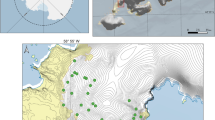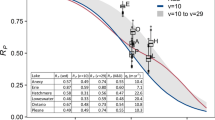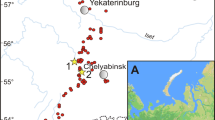Abstract
The physical characteristics of surface sediments from a suite of pristine lakes on Signy Island, maritime Antarctic, were used to develop a quantitative link between catchment ice-extent and lake-sediment response. Percentage dry weight, median particle size, percentage loss-on-ignition and wet density of the lakes' surface sediments were the most significant variables explaining contemporary catchment ice-extent. Two independent reconstruction models – Partial Least Squares (PLS) and a Modern Analog Technique (MAT) – were applied to dated sediment cores at two sites on Signy Island. The validity of the reconstructions was tested against historical information on catchment ice-extent. With sufficiently high sedimentation rates and sampling resolution, the models can predict sub-decadal changes in ice-extent. The model results are best regarded as indicators of erosion resulting from meltwater activity in the catchment. Comparison of results with Twentieth Century climate records affirms the hypothesis that climatic warming is the most likely cause for the ice retreat observed on Signy Island during the last 40 yrs. Similar reconstruction models using these simple sedimentary measures could be developed for analogous locations in the Antarctic and in Arctic and Alpine regions.
Similar content being viewed by others
References
Anderson, P. M, P. J. Bartlein, L. B. Brubacker, K. Gajewski & J. C. Ritchie, 1989. Modern analogues of late-Quaternary pollen spectra from the western interior of North America. J. Biogeogr. 16: 573–596.
Appleby, P. G., V. J. Jones & J. C. Ellis-Evans, 1995. Radiometric dating of lake sediments from Signy Island (maritime Antarctic): evidence of recent climatic change. J. Paleolim. 13: 179–191.
Ballantyne, C. K. & D. I. Benn, 1994. Paraglacial slope adjustment and resedimentation following glacier retreat, Fåbergstolsdalen, Norway. Arct. Alp. Res. 20: 255–269.
Bartlein P. J. & C. Whitlock, 1993. Palaeoclimatic interpretation of the Elk Lake pollen record. Geol. Soc. Am. Special Paper 276: 275–293.
Birks, H. J. B., 1995. Quantitative palaeoenvironmental reconstructions. In Statistical Modelling of Quaternary Science Data. Technical Guide 5, Quaternary Research Association, Cambridge, pp. 161–254.
Birks, H. J. B., 1998. Numerical tools in palaeolimnology-progress, potentialities, and problems. J. Palaeolim. 20: 307–322.
Björck, S., H. Håkansson, R. Zale, W. Karlén & B. L. Johnsson, 1991. A late Holocene lake sediment sequence from Livingston Island, South Shetland Islands, with palaeoclimatic interpretations. Antarct. Sci. 3: 61–72.
Björck, S., H. Håkansson, S. Olsson, L. Barnekow & J. Janssens, 1993. Palaeoclimatic studies in South Shetland Islands, Antarctica, based on numerous stratigraphic variables in lake sediments. J. Paleolim. 8: 233–272.
Björck, S., S. Olsson, C. Ellis-Evans, H. Håkansson, O. Humlum & J. M. de Lirio, 1996. Late Holocene palaeoclimatic records from lake sediments on James Ross Island, Antarctica. Palaeogeogr. Palaeoclim. Palaeoecol. 121: 195–220.
Church, M. & J. M. Ryder, 1972. Paraglacial sedimentation: A consideration of fluvial processes conditioned by glaciation. Geol. Soc. Am. Bull. 83: 3059–3072.
Cleveland, W. S., 1979. Robust locally-weighted regression and smoothing scatterplots. J. Am. Statist. Assoc. 74: 829–836.
Cooper, D. W., 1968. The significance level in multiple tests made simultaneously. Heredity 23: 614–617.
Dean, W. E. Jr., 1974. Determination of carbonate and organic matter in calcareous sediment and sedimentary rock by loss on ignition: comparison with other methods. J. Sed. Petrol. 44: 241–248.
Desloges, J. R., 1994. Varve deposition and the sediment yield record at three small lakes of the southern Canadian Cordillera. Artc. Alp. Res. 26: 130–140.
Ellis-Evans, J. C., 1990. Evidence for change in the chemistry of maritime Antarctic Heywood Lake. In Kerry K. R. & G. Hempel (eds), Antarctic Ecosystems-Ecological Change and Conservation, Proc. 5th SCAR Symposium on Antarctic Biology. Springer-Verlag, Berlin, pp. 77–82.
Engstrom, D. R. & H. E. Wright Jr., 1984. Chemical stratigraphy of lake sediments as a record of environmental change. In Haworth E. Y. & J. W. G. Lund (eds), Lake sediments and environmental history. Studies in palaeolimnology and Palaeoecology in honour of Winifred Tutin. Leicester University Press, pp. 11–67.
Fenton, J. H. C., 1982. Vegetation re-exposed after burial by ice and its relationship to changing climate in the South Orkney Islands. Br. Ant. Surv. Bull. 51: 247–255.
Gardiner, M. J., 1999. Snowmelt modelling in Paternoster Valley, Signy Island, Antarctica. PhD Thesis, University of Bristol: 295 pp.
Glew, J. R., 1991. Miniature gravity corer for recovering short sediment cores. J. Paleolim 5: 285–287.
Gordon, J. E. & R. J. Timmis, 1992. Glacier fluctuations on South Georgia during the early 1970s and early 1980s. Antarctic Sci. 4: 215–226.
Håkanson, L. & M. Jansson, 1983. Principles of lake sedimentology. Springer-Verlag, Berlin Heidelberg, pp. 316.
Hardy, D. R., R. S. Bradley & B. Zolitschka, 1996. The climatic signal in varved sediments from Lake C2, northern Ellesmere Island, Canada. J. Palaeolim. 16: 227–238.
Heywood, R. B., 1967. Ecology of the freshwater lakes of Signy Island, South Orkney Islands: I. Catchment areas, drainage systems and lake morphology. Brit. Ant. Surv. Bull. 14: 25–43.
Heywood, R. B., H. J. G. Dartnall & J. Priddle, 1979. The freshwater lakes of Signy Island, South Orkney Islands, Antarctica. British Antarctic Survey Data 3, pp. 46.
Heywood, R. B., H. J. G. Dartnall & J. Priddle, 1980. Characteristics and classification of the lakes of Signy Island, South Orkney Islands, Antarctica. Freshwat. Biol. 10: 47–59.
Hodgson, D. A., N. M. Johnston, A. P. Caulkett & V. J. Jones, 1998. Palaeolimnology of Antarctic fur seal Arctocephalus gazella populations and implications for Antarctic management. Biol. Cons. 83: 145–154.
Holdgate, M. W., 1964. Terrestrial ecology in the Maritime Antarctic. In Carrick, R., M. W. Holdgate & J. Provost (eds), Biologie Antarctique. Hermann, Paris, pp. 181–194.
Jones, P. D., S. C. B. Raper & T. M. L. Wigley, 1986. Southern Hemisphere surface air temperature variations: 1851–1984. J. Clim. Appl. Meteorol. 25: 1213–1230.
Jones, V. J., 1993. The use of diatoms in lake sediments to investigate environmental history in the Maritime Antarctic: an example from Sombre Lake, Signy Island. Antarctic Special Topic, 91–95.
Jones, V. J. & S. Juggins, 1995. The construction of a diatombased chlorophyll-a transfer function and its application at three lakes on Signy Island (maritime Antarctic) subject to differing degrees of nutrient enrichment. Freshwat. Biol. 34: 433–445.
Jones, V. J., D. A. Hodgson & A. Chepstow-Lusty, 2000. Palaeolimnological evidence for marked Holocene environmental changes on Signy Island, Antarctica. The Holocene 10: 43–60.
Juggins, S., 1994. Program MAT-Modern Analog Technique, Version 1.0, Department of Geography, University of Newcastle, Newcastle-upon-Tyne, NE1 7RH, UK.
Juggins, S., R. W. Battarbee & S. C. Fritz, 1994. Diatom/salinity transfer functions and climate change: an assessment of methods and application to two Holocene sequences from the northern Great Plains, North America. In Funnell, B. M. & R. L. F. Kay (eds), Palaeoclimate of the Last Glacial/ Interglacial Cycle. Special Publication 94/2 of the NERC Earth Sciences Directorate, pp. 37–41.
Juggins, S. & C. J. F. ter Braak, 1996. CALIBRATE Version 0.61 (Beta Test)-A Computer Program for Species-Environmental Calibration by [Weighted-Average] Partial Least Squares Regression. ECRC, University College London, UK.
Karlén, W., 1981. Lacustrine sediment studies. A technique to obtain a continuous record of Holocene glacier variations. Geog. Annal. 63A: 273–279.
Karlén, W. & J. A. Matthews, 1992. Reconstructing Holocene glacier variations from glacial lake sediments: studies from Nordvestlandet and Jostedalsbreen-Jotunheimen, southern Norway. Geog. Annal. 74A: 327–347.
Korsman, T. & H. J. B. Birks, 1996. Diatom-based water chemistry reconstructions from northern Sweden: a comparison of reconstruction techniques. J. Palaeolim. 15: 65–77.
Krausse, G. L., C. L. Schelske & C. O. Davis, 1983. Comparison of three wet-alkaline methods of digestion of biogenic silica in water. Freshwat. Biol. 13: 73–81.
Leeman, A. & F. Niessen, 1994a. Varve formation and the climatic record in an Alpine proglacial lake: calibrating annually laminated sediments against hydrological and meteorological data. The Holocene 4: 1–8.
Leeman, A. & F. Niessen, 1994b. Holocene glacial activity and climatic variations in the Swiss Alps: reconstructing a continuous record from proglacial lake sediments. The Holocene 4: 259–268.
Lemmen, D. S., R. Gilbert, J. P. Smol & R. I. Hall, 1988. Holocene sedimentation in glacial Tasikutaaq Lake, Baffin Island. Can. J. Earth. Sci. 25: 810–823.
Leonard, E. M., 1985. Glaciological and climatic controls on lake sedimentation, Canadian Rocky Mountains. Zeitschrift für Gletcherkunde und Glazialgeologie 21: 35–42.
Leonard, E. M., 1986. Varve studies at Hector Lake, Alberta, Canada, and the relationship between glacial activity and sedimentation. Quat. Res. 25: 199–214.
Martinez-Macchiavello, J. C., A. Tatur, S. Servant-Vildary & R. del Valle, 1996. Holocene environmental change in a marine-estuarine-lacustrine sediment sequence, King George Island, South Shetland Islands. Ant. Sci. 8: 313–322.
Mackereth, F. J. H., 1966. Some chemical observations on post-glacial lake sediments. Phil. Trans. R. Soc. Lond. B 250: 165–213.
Mäusbacher, R., J. Müller & R. Schmidt, 1989. Evolution of postglacial sedimentation in Antarctic lakes (King George Island). Z. Geomorph. N.F. 33: 219–234.
Nesje, A., S. O. Dahl, R. Lovlie & J. R. Sulebak, 1994. Holocene glacier activity at the southwestern part of Hardangerjokulen, central-southern Norway: evidence from lacustrine sediments. The Holocene 4: 377–382.
Noon, P. E., 1997. Recent environmental change at Signy Island, maritime Antarctic: quantitative lake-sediment studies as a basis for reconstructing catchment ice-cover. PhD Thesis, University of London, 460 pp.
Oerlemans, J., 1989. On the response of valley glaciers to climatic change. In Oerlemans, J. (ed.), Glacier fluctuations and climatic change. Kluwer Academic Publishers, pp. 353–371.
Oldfield, F., 1977. Lakes and their drainage basins as units of sediment-based ecological study. Prog. Phys. Geogr. 1: 460–504.
Oppenheim, D. R. & J. C. Ellis-Evans, 1989. Depth-related changes in benthic diatom assemblages of a maritime Antarctic lake. Polar Biol. 9: 525–532.
Overpeck, J. T., T. Webb & I. C. Prentice, 1985. Quantitative interpretation of fossil pollen spectra: dissimilarity coefficients and the method of modern analogs. Quat. Res. 23: 87–103.
Priddle, J. & H. J. Belcher, 1982. An annotated list of benthic algae (excluding diatoms) from freshwater lakes on Signy Island. Brit. Ant. Surv. Bull. 57: 41–53.
Raper, S. C. B., T. M. L. Wigley, P. R. Mayer, P. D. Jones & M. J. Salinger, 1984. Variations in surface air temperatures. Part 3: the Antarctic, 1957–1982. Monthly Weather Rev. 112: 1341–1353.
Smith, R. I. L., 1988. Destruction of Antarctic terrestrial ecosystems by a rapidly increasing fur seal population. Biol. Cons. 45: 55–72.
Smith, R. I. L., 1990. Signy Island as a paradigm of biological and environmental change in Antarctic terrestrial ecosystems. In Kerry K. R., & G. Hempel (eds), Antarctic ecosystems-Ecological Change and Conservation. Proc. 5th SCAR Symposium on Antarctic Biology, Springer-Verlag, Berlin, pp. 30–48.
Smol, J. P., I. R. Walker & P. R. Leavitt, 1991. IV. Palaeolimnology. Palaeolimnology and hindcasting climatic trends. Verh. Internat. Verein. Limnol. 24: 1240–1246.
Smol, J. P. & M. S. V. Douglas, 1996. Long-term monitoring in Arctic lakes and ponds using diatoms and other biological indicators. Geoscience Canada 23: 225–230.
ter Braak, C. J. F., 1988. CANOCO-a FORTRAN program for canonical community ordination by [partial] [detrended][canonical] correspondance analysis, principal components analysis and redundancy analysis (version 2.1). Technical Report LWA–88–02. Agricultural Mathematics Group, Wageningen.
ter Braak, C. J. F., 1990. Update notes: CANOCO version 3.10. Agricultural Mathematics Group, Wageningen.
ter Braak, C. J. F., 1995. Non-linear methods for multivariate statistical calibration and their use in palaeoecology: a comparison of inverse (K-nearest neighbours, partial least squares and weighted averaging partial least squares) and classical approaches. Chemometr. Intell. Lab. Syst. 28: 165–180.
ter Braak, C. J. F. & S. Juggins, 1993. Weighted-averaging partial least squares regression (WA-PLS): an improved method for reconstructing environmental variables from species assemblages. Hydrobiologia 269/270: 485–502.
Thompson, R. & F. Oldfield, 1986. In Environmental magnetism. Allen & Unwin, London, 227 pp.
Wasell, A. & H. Håkansson, 1992. Diatom stratigraphy in a lake on Horseshoe Island, Antarctica: a marine-brackishfreshwater transition with comments on the systematics and ecology of the most common diatoms. Diat. Res. 7: 157–194.
Author information
Authors and Affiliations
Rights and permissions
About this article
Cite this article
Noon, P., Birks, H., Jones, V. et al. Quantitative models for reconstructing catchment ice-extent using physical-chemical characteristics of lake sediments. Journal of Paleolimnology 25, 375–392 (2001). https://doi.org/10.1023/A:1011193401627
Issue Date:
DOI: https://doi.org/10.1023/A:1011193401627




